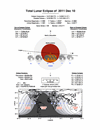- - text and links as of last publication - -
![]()
This second, and last, Moon eclipse in 2011 is again a total lunar eclipse, like the one last June. With a total phase lasting 51 minutes, Moon is passing in the southern part of the Earth's umbra and the whole eclipse is lasting 5 hours and 57 minutes. The December 10th, 2011 eclipse is seen over the Far East and the western Pacific Ocean. With Moon's northern limb by 33.3 arc-minutes from the umbra's edge as southern limb at 3.2 arc-minutes from the southern edge only, that eclipse should have the northern half of the Moon much darker than the southern one because as it lies deeper in the umbra. A total lunar eclipse if a fine show worth the observation, with Moon progressively occulted and darkened by Earth's 'umbra,' giving a deep sense of the astronomical scales of the Universe and the large events which may occur there. for more about Moon eclipses, theoretically, see our tutorial: Moon Eclipses
The whole of the eclipse is observable from northwestern China and Southeast Asia up to Alaska and the western part of the Pacific Ocean, as Australia also sees the entire eclipse. Europe, the Middle East, India and most of Africa are having the eclipse already en cours by moonrise at the USA, Canada, most of Central America and New Zealand have it interrupted by moonset. Westernmost Africa, and South America do not have any eclipse at all
The eclipse's main data are the following (data as of November 2010). for more about how to observe a lunar eclipse, see our tutorial "Observing a Moon Eclipse":
- umbral magnitude (fraction of Moon's diameter immersed in the umbra at greatest): 1.1061
- greatest eclipse: 14:31:48.5 UT
- eclipse semi-duration (penumbral): 02h 56m 14s
- eclipse semi-duration (umbral): 01h 46m 08s
- total eclipse duration: 00h 51m 08s
- eclipse contacts (in UT): P1 at 11:33:32, U1 at 12:45:42, U2 at 14:06:16, U3 at 14:57:24, U4 at 16:17:58, P4 at 17:30:00
 | see a map of the December 10th, 2010 total lunar eclipse (path of the Moon within the Earth's umbra and map of the visibility of the eclipse worldwide). map courtesy map courtesy Fred Espenak - NASA/GSFC |
By the time of greatest, the occulted Moon is seen against the background of the winter constellations, with a number of bright stars useable for magnitude quantifications: Aldebaran (0.85), Betelgeuse (0.50), Pollux (1.14), or Capella (0.08)
. for more about this eclipse and for more about solar and lunar eclipses generally, you may see at Fred Espenak's NASA's eclipse website
Observation Reports: no special report was made about that eclipse
Website Manager: G. Guichard, site 'Amateur Astronomy,' http://stars5.6te.net. Page Editor: G. Guichard. last edited: 1/1/2011. contact us at ggwebsites@outlook.com